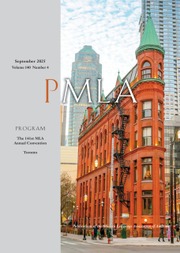No CrossRef data available.
Article contents
The Slogan and the Map
Published online by Cambridge University Press: 28 October 2025
Abstract
An abstract is not available for this content so a preview has been provided. Please use the Get access link above for information on how to access this content.

Information
- Type
- Theories and Methodologies
- Information
- Copyright
- © 2025 The Author(s). Published by Cambridge University Press on behalf of Modern Language Association of America
References
Works Cited
Allen, Ernie. “Dying from the Inside: The Decline of the League of Revolutionary Black Workers.” They Should Have Served That Cup of Coffee: Seven Radicals Remember the Sixties, edited by Cluster, Dick, South End Press, 1979, pp. 71–109.Google Scholar
Althusser, Louis. “Ideology and Ideological State Apparatuses.” Lenin and Philosophy, Monthly Review Press, 1971, pp. 127–86.Google Scholar
Bérubé, Michael, et al. “Former Modern Language Association Presidents Call for BDS Vote.” Literary Hub, 18 Dec. 2024, lithub.com/8-former-modern-language-association-presidents-call-for-bds-vote/.Google Scholar
Boynik, Sezgin, editor. Coiled Verbal Spring: Devices of Lenin’s Language. Translated by Thomas Campbell and Mikko Viljanen, Rab-Rab Press, 2018.Google Scholar
Boynik, Sezgin. “Out of Synch with the Thing: Introduction to Devices of Lenin’s Language.” Boynik, Coiled Verbal Spring, pp. 5–135.Google Scholar
Colesworthy, Rebecca. “Resigning to and from the MLA.” Remaking II: Long Revolution, 17 Jan. 2025, utotherescue.blogspot.com/2025/01/resigning-from-and-to-mla-guest-post.html.Google Scholar
Davis, Angela Y.. Freedom Is a Constant Struggle: Ferguson, Palestine, and the Foundations of a Movement. Haymarket Books, 2016.Google Scholar
Flatley, Jonathan. “How a Revolutionary Counter-Mood Is Made.” New Literary History, vol. 43, no. 3, 2012, pp. 503–25.10.1353/nlh.2012.0028CrossRefGoogle Scholar
Flatley, Jonathan. “Refreshments of Revolutionary Mood.” Literary/Liberal Entanglements: Toward a Literary History for the Twenty-First Century, edited by Corinne Harol and Mark Simpson, U of Toronto P, 2017, pp. 103–47.Google Scholar
Georgakas, Dan, and Surkin, Marvin. 1975. Detroit: I Do Mind Dying: A Study in Urban Revolution. Updated ed., South End Press, 1998.Google Scholar
Geschwender, James A. Class, Race, and Worker Insurgency: The League of Revolutionary Black Workers. Cambridge UP, 1977.Google Scholar
Gilmore, Ruth Wilson. “Ruth Wilson Gilmore Makes the Case for Abolition.” Hosted by Chenjerai Kumanyika. Intercepted, 10 June 2020. The Intercept, theintercept.com/2020/06/10/ruth-wilson-gilmore-makes-the-case-for-abolition/.Google Scholar
Jameson, Fredric. Archaeologies of the Future: The Desire Called Utopia and Other Fictions. Verso, 2005.Google Scholar
Jameson, Fredric. “Cognitive Mapping.” Marxism and the Interpretation of Culture, edited by Cary Nelson and Lawrence Grossberg, U of Illinois P, 1988, pp. 347–57.Google Scholar
Jameson, Fredric. “‘Fredric Jameson: The Latest Talk in Italy’ (Iuno, Rome, Tuesday, May 28, 2024).” YouTube, uploaded by Daniele Balicco, 23 Sept. 2024, www.youtube.com/watch?v=jI_lUxjCxrQ.Google Scholar
Jameson, Fredric. “Future City.” New Left Review, no. 21, May-June 2003, pp. 65–79.10.64590/dwkCrossRefGoogle Scholar
Jameson, Fredric. “Lenin and Revisionism.” Lenin Reloaded: Toward a Politics of Truth, edited by Budgen, Sebastian et al., Duke UP, 2007, pp. 59–73.10.1215/9780822389552-005CrossRefGoogle Scholar
Jameson, Fredric. The Political Unconscious: Narrative as a Socially Symbolic Act. Cornell UP, 1981.Google Scholar
Jameson, Fredric. Postmodernism; or, The Cultural Logic of Late Capitalism. Duke UP, 1991.10.1215/9780822378419CrossRefGoogle Scholar
Kaba, Mariame. We Do This ’til We Free Us: Abolitionist Organizing and Transforming Justice. Haymarket Books, 2021.Google Scholar
Kornbluh, Anna. “Solidarity Words.” Differences, vol. 33, nos. 2–3, 2022, pp. 33–55.10.1215/10407391-10124662CrossRefGoogle Scholar
Kushner, Rachel. “Is Prison Necessary? Ruth Wilson Gilmore Might Change Your Mind.” The New York Times, 17 Apr. 2019, www.nytimes.com/2019/04/17/magazine/prison-abolition-ruth-wilson-gilmore.html.Google Scholar
Lecercle, Jean-Jacques. “Lenin the Just; or, Marxism Unrecycled.” Lenin Reloaded: Toward a Politics of Truth, edited by Sebastian Budgen et al., Duke UP, 2007, pp. 269–82.Google Scholar
Lenin, Vladimir. “On Slogans.” Collected Works, vol. 25, Progress Publishers, 1964, pp. 185–92.Google Scholar
Lenin, Vladimir. What Is to Be Done? Burning Questions of Our Movement. Translated by Lars T. Lih. Lenin Rediscovered: What Is to Be Done? in Context, by Lih, Haymarket Books, 2008, pp. 673–840.Google Scholar
Marx, Karl. The Eighteenth Brumaire of Louis Bonaparte. International Publishers, 1963.Google Scholar
Mayakovsky, Vladimir, et al. Lenin’s Language. Translated by Thomas Campbell. Boynik, Coiled Verbal Spring, pp. 145–273.Google Scholar
Mieslowski, Jan. “What’s in a Slogan?” Mediations, vol. 29, no. 2, 2016, mediationsjournal.org/articles/whats-in-a-slogan.Google Scholar
Seybold, Matt. “What the MLA Is….” The American Vandal, 8 Jan. 2025. Substack, theamericanvandal.substack.com/p/what-the-mla-is.Google Scholar
Spivak, Gayatri Chakravorty. “Can the Subaltern Speak?” Marxism and the Interpretation of Culture, edited by Cary Nelson and Lawrence Grossberg, U of Illinois P, 1988, pp. 271–313.Google Scholar
Táíwò, Olúfẹmi O. Elite Capture: How the Powerful Took Over Identity Politics (and Everything Else). Haymarket Books, 2022.10.2307/j.ctv2g591sqCrossRefGoogle Scholar
Taylor, Kieran. “American Petrograd: Detroit and the League of Revolutionary Black Workers.” Rebel Rank and File: Labor Militancy and Revolt from Below during the Long 1970s, edited by Aaron Brenner et al., Verso, 2010, pp. 311–33.Google Scholar
Thompson, Heather Ann. Whose Detroit? Politics, Labor, and Race in a Modern American City. Cornell UP, 2001.Google Scholar
Watson, John. “Black Editor: An Interview.” Radical America, vol. 2, no. 4, July-Aug. 1968, pp. 30–38.Google Scholar
Žižek, Slavoj. “Larger than Life.” Žižek Goads and Prods, 28 Sept. 2024. Substack, slavoj.substack.com/p/larger-than-life.Google Scholar

